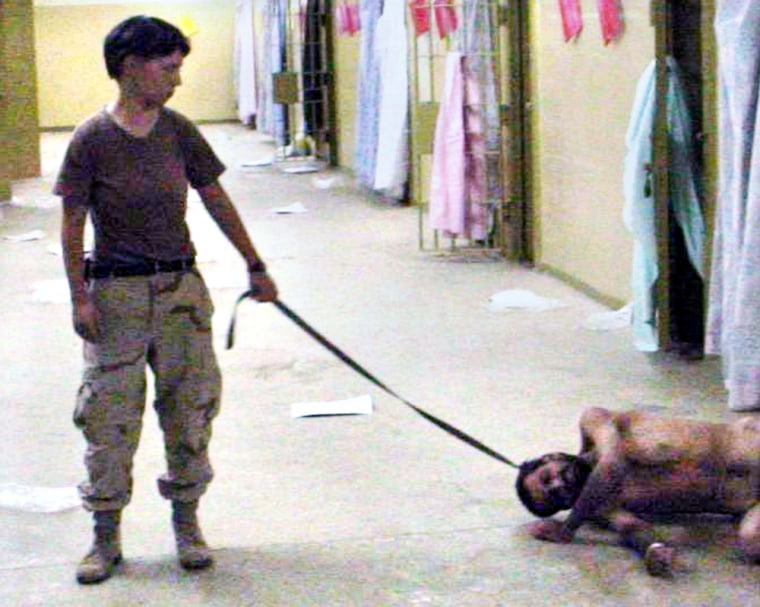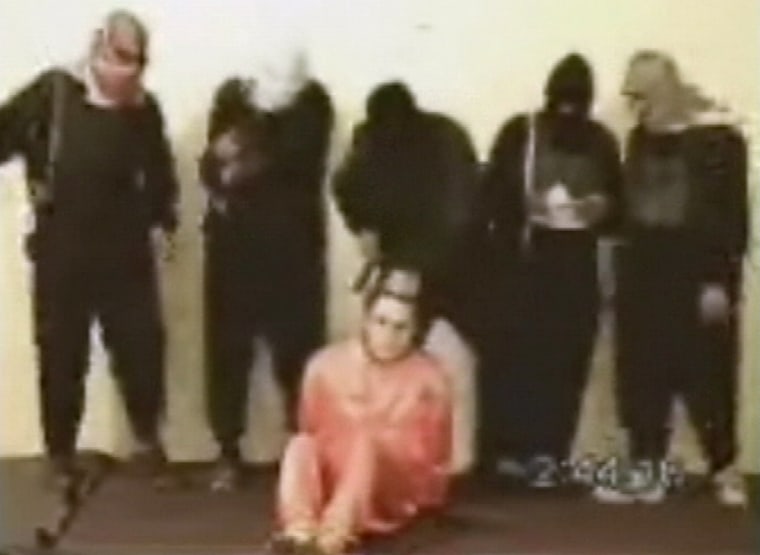There are striking images from every war that help shape—and sometimes alter— public opinion. They become moments in history that live on for generations.
On 'Deborah Norville Tonight' last Tuesday, former war correspondents, and magazine editors discussed three of the most controversial images of this war— the photo of the flag-drapped coffins, the photos of Iraqi prisoner abuse, and the video of Nick Berg’s beheading.
Flag-drapped coffins
Photographs of America's war dead, beautifully lined-up and carefully tended by the soldiers, were published in Seattle Times and the Internet, and became a divisive issue. The Bush administration initially didn't want anybody to see pictures of coffins coming back from Iraq, because they said the photos were upsetting to the fallen soldiers' families, and that they undermined the effort of troops abroad.

Tom Jarriel, former correspondent for ABC News, thinks that Americans needed to see these photographs. “This was an effort by the Pentagon to do what they have so often done, which was try to control the media,” he says. “They try to prevent Americans from seeing the toll that the war is taking in terms of graphic pictures, so that they don‘t lose public support for the war. I am totally convinced that [censorship] was not for the men who have died and their families. It was entirely to control public opinion from going against the war.”
William Stewart, former war correspondent for “Time magazine” compares these photos to the way British treat their returning war dead. “They are given a ceremonial return, [and are] treated with great dignity, honor and respect. I would have thought this would have worked for the administration, rather than against it."
Ralph Graves, who was a managing editor at "Life magazine," remembered his magazine’s decision to publish a week’s worth of war dead during the Vietnam war. “We wanted people to realize that these were not just numbers. We wanted people to see that these are real men and that they are very young and they are dead. And it was the highest impact story that we ran on Vietnam. Families of the soldiers loved it. In fact, we got the pictures from the families.”
Prisoner abuse
The pictures of prisoners being abused in Iraq have also dramatically changed the image of the war. At one time, the most notable picture of this war was of jubilant Iraqis pulling down the statue of Saddam Hussein. Today, that's been replaced by horrific images of abuse of Iraqi prisoners by American soldiers.

For Ed Wakin, author of “How TV Changed America’s Mind” the photo of the prisoner on a leash has a distinctive quality. “It‘s staged, which is unusual in the history of impact-making photos. It’s an iconic photo and it will be used to characterize this event much to the disadvantage of the United States. It‘s saying 'We‘re abandoning the high ground,' which is not true."
The fact that a woman is pictured is also powerful: "The image plays very heavily in the Middle East, particularly the idea of a woman holding a man on a leash," says Wakin. "The degradation of the male is a powerful symbol. In many ways, it will reflect the way Americans and foreigners will see this episode: It went too far. And that simple picture, that man with the woman holding the leash, is a powerful image that just won‘t go away. “
Jarriel thinks that he hasn’t seen a story like this have legs, since the years he’s spent covering Watergate. “The legs go all the way from that remote, horrible prison, up the ranks through Congress, into the Pentagon, and all the way to the White House. The problem is, we are just seeing the tip of the iceberg."
Sydney Schanberg, a former war correspondent for “The New York Times,” thinks that the photographs may be the proverbial straw that breaks the camel’s back. “People are seeing that this is a failed policy, that our soldiers are now at much greater risk.” He adds that the reason we are so shocked as a culture by pictures, is that we are anaesthetized to the fact that war is bestial. “We are not shown all of the horrors. There‘s been torture probably since the beginning of man. There was torture in South Vietnamese prisons of Viet Cong prisoners who were overseen and trained by Americans. There's always been torture on both sides. And yet these pictures have a much greater power because we‘ve been led to believe, in particular by this administration, who is much given to secrecy, that war is a cakewalk. We’re led to believe that it can be sanitized, and that nothing is really bad. We are living in a fantasy world. And I believe these pictures destroy that fantasy.”
Nick Berg's last moments

The latest disturbing images of this war is the videotaped beheading of an American civilian. The video comes from an Islamic militant web site. It shows 26-year-old Nick Berg of West Chester, Pennsylvania, being beheaded.
Five men wearing headscarves and masks stand over Berg. After reading a statement, the men put a knife to his neck and cut off his head. Berg‘s body was later found on a highway overpass in Baghdad on Saturday.
For Jarriel, this was a calculated effort by the terrorists: “The first impact they want is terror on everyone. The second impact they want is to carry favor within the Islam world. And impact three is to cause problems for the United States.”
Schanberg thinks that while the pictures might have the desired effect on the Islamic population, it might have a reverse effect in the Western world. “It might even mute Western outrage and disappointment in Americans abusing Iraqi prisoners, because here, these people are doing something even more ghastly,” he says.
Throughout history, moments of war that have been captured deeply affected millions of people— from the American flag being raised on Iwo Jima, to a little girl fleeing to safety in Vietnam. For these journalists, suppression is never the answer.
“I think if you‘re telling news in pictures, you have to show the pictures,” says Graves. “You can‘t suppress them.”
“Pictures carry an emotional truth to it that words alone can‘t carry, and it resonates far beyond the written article,” added Stewart.
The technology available these days also makes suppression moot. Cameras are everywhere and are smaller. Images are digital and can be transmitted instantaneously.
“It’s an instantaneous information culture,” says Schanberg. “The way to deal with that is to let the stuff flow and not to react to everything. Maybe we will finally know how to sift through some of this information. I think we should see everything, because the problem here is that you lose the moral high ground when you use secrecy as a primary weapon.”
“We will see more of these,” agrees Wakin. “And the lesson for everyone to learn is that there‘s no such thing as an alternative to full disclosure. They will come out anyhow."